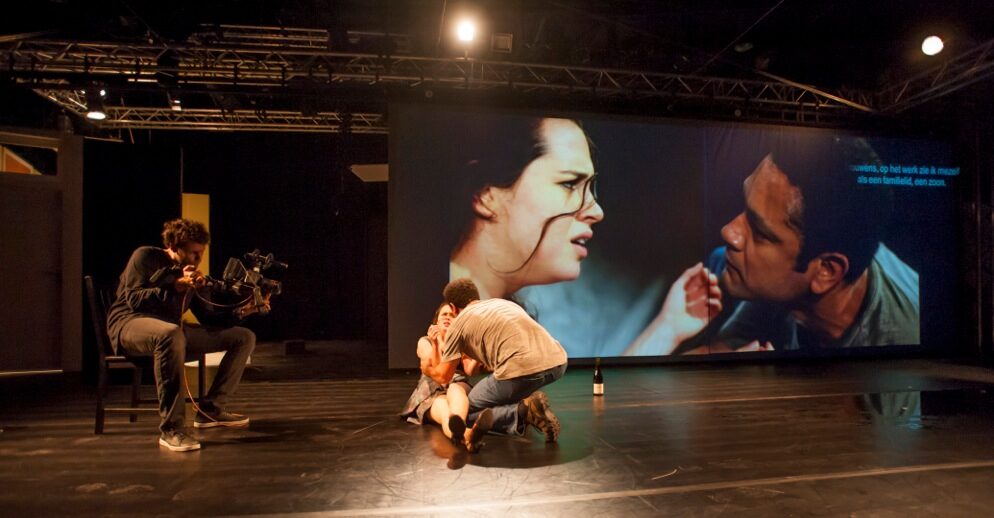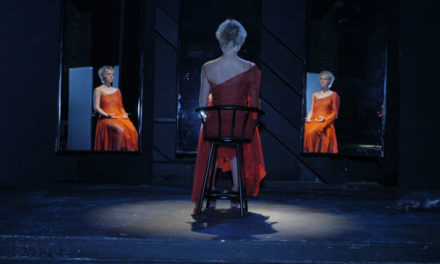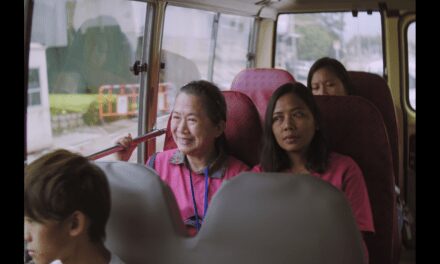Created and directed by Christiane Jatahy, E se elas fossem para Moscou? is comprised of two versions, always displayed simultaneously: the theatre one, in which the audience watches the staging directly; and the cinema version, where different spectators watch a movie that is edited in real time, from the filmings of the performance taking place in the theatre.
Research Group :
Do you think you could work without images, film or screens on stage?
Christiane Jatahy:
Yes. I have worked on many projects without cameras and imagery on the stage. The first project in which I used a camera on stage was Julia. Before that, I also worked with surveillance cameras in Corte Seco. Images were projected on the screen, but it was more about how the image revealed what was not in the frame, and then showed new perspectives on what was in the frame. I live in a dangerous country [Brazil] that has a lot of surveillance cameras. In this work, I wondered how I could use this device to show what is impossible to see in its frame. But I believe it’s possible to do theater without images and without cameras. In order to use projections and cameras optimally, they have to be part of the dramaturgy. The results, not my focus; it is more about finding tools that will allow me to create layers, to form a closeness with the audience and to strengthen the relationships among the actors. My background and first inspiration was cinema. Therefore, I am always working with two media: theater and cinema. When I bring them together, it creates an in-between space, and this is what is really meaningful to me. It has nothing to do with the contemporary or modern aspects of using technologies on stage.
You have found the space between film and theater o be a fertile area for your creativity?
Yes. When you use video onstage, you are free to multiply the points of view. You can create something that is challenging for the audience. I discovered a lot of conceptual possibilities by using filmic codes on stage. Not exactly videography, actual cinema, in conjugation with theater. That is why I created Julia, and then I worked with cameras and cinema again in Moscow, and I will use cinema and theater onstage in my next production.
Between Cinema and Theater
You talked about the influence of video surveillance on your work and the ability of filmic codes to multiply the stage perspectives. Would you say that you include the question of voyeurism in your work? If so, what does it bring to your work?
I do work a lot with voyeurism. I feel it is included in my practice on two levels. First, it concerns what happens between the actors, and what happens between the actors and the stage and also the audience. I have a company that is called Vertice. A vertex (vertice is the plural) is a point where two edges meet, creating an angle in a triangle, for example. I find this concept of junction truly inspiring. When I work, I like to keep in mind these geometric matters. A fundamental aspect of my work is to create alternative possibilities for the audience. When I use voyeurism, I use it in a way that it opens up possibilities. When I stage a performer who is seeing only a fragment of the whole image, the audience is confronted by the knowledge that they are the only ones who see the whole situation. I am able to drift the perspectives via the editing process. My direction of the play is calculated to stimulate the audience, to mobilize their perception. I believe that unveiling the construction of an image onstage allows the spectator to realize the multiple possibilities that these images offer. It opens up space where the spectator becomes active, not passive. I give the audience the opportunity to use its own intelligence, its perception, and its background, to create, along with me, a final visual and conceptual message. It is also about the in-between space that I evoked earlier. This space is the interstice, in between cinema and theater, but it is also the space between my creation and your interpretation. I really think about that when I work. When I use cinema on stage, there is this part of me trying intellectually to stimulate the spectator, to sensitize him to this focal point.
So you create a trajectory that is balanced between cinema and theater, and the possibilities you display onstage spark the spectator’s creativity?
Exactly. And the use of media and projections is just one of these possibilities. It is one layer. That’s why I say that the videographic work becomes part of the dramaturgical narrative; it is not solely about aesthetics. Of course, it becomes artistic, but it this is an on-going process. Onstage, I am trying to figure out how to create a real rapport with the spectator. My work is very light, and induces an intimacy with the spectator. I try to really talk to them, attempting to grasp the present moment through the stage. I do not think of the audience as a mass. I am interested in the individuality among them. The acting style is very intimate and might seems quotidian or naturalistic, but it is not exactly so. It is about what happens between people who are in the theater. In this context, the use of video allows me to create an authentic closeness, to the point where you can feel all the power of a small change in the actors’ eyes.
Do you think that the actors you work with are more performers, more actors, or simply individuals? What do you seek in actors?
First, I seek people who allow themselves to be affected. I work with different actors, but I ask the same from each of them. I ask them to be able to adapt to what happens on stage. If I am speaking with you and I realize that there is ambient noise, I need to change my way of speaking. It impacts my feelings and my emotions. Before those noises I was calm, but now this environment changes my state of mind. Nonetheless, I am still with you. That’s what I ask the actors. No negativity. Don’t say no to anything. Use everything that happens in the space, in the theater, with the cameras. But don’t give up the relationship. Put what happens on stage into the relationship. This is so simple, but at the same time so difficult, because theater actors needs to repeat the same actions from one night to another. With cinema, I can shoot a specific moment, and keep the scene forever. This is why I feel that the space in between in theater is so important: you need to focus on much more than what happens between me and you, at the moment when I look in your eyes. It is more about what is happening between the character and simultaneously with the other person as a human being. Of course, you will react to what I do, but you also need to react to what I am. I work with this intimacy, these relationships, in a very strong, deep and crazy way. Every time I challenge the actors, they never lose the connection they are sharing. It is always about the relationship. The relationship between you and the camera, the relationship between you and me, the relationship between two objects, and the relationship between two stories. In between everything – it flows. It is perhaps about losing control. Because if the relationship is not in you, or in me, I don’t have control, and you don’t either.
Relationships: Organicity and Technology
I think this is why your theater is so organic to watch. Even on video, I was overwhelmed by its liveliness. You talked about relationship dynamics. How does this happen in the creative process? What kinds of dialogue do you have with your actors about the screens and devices onstage?
The technology in this work makes the relationship and not the opposite. It is a tool that I use to approximate the audience. It does not become problematic, because the people in the audience use this technology themselves. It is a challenge, but not a problem.
Usually, when I begin the creative process, I know exactly what I want, but I am open to other alternatives. The content, the text, and the space, are already conceptualized in my mind. I create the space before I even think of anything else. Space is the first limit, and I work a lot with limits. To stimulate freedom I have to put down a somewhat limited or restraining climate, because those limits nourish creativity, and allow ideas to emerge as solutions. When these limits are set, when I have figured out the space, the text, or the structure of the dramaturgy, then I know where I want to take the project. In the case of Julia, I knew that I would use cameras, and I knew that the set was going to be on that stage. In Moscow, I knew that it would be happening between two spaces. Since scenography is my first concern in this process, the first person consult is the set designer. When I start getting the first ideas, he’s already drawing; he starts developing the project. Of course, my ideas and decisions are always subject to a bit of change, to integrate new possibilities that will be coming from him. A set designer is a creator, an artist.
The tricky part is not to change it too much, not to lose the essence of your ideas. Creation is like a ring–a precious stone that your team starts to polish, but even though they do polish it, it has to stay the same original rock, and not be replaced by a new one. Finally, when I get in the studio, in rehearsal, we start creating in collaboration. With Julia, the actors did not collaborate so much. The text was already defined. In Moscow, though, we started with a dramaturgic structure, and they collaborated a lot with the dialogues and the scenes.
On the other side, when I am suggesting an improvisation, I am working with systems. There is a framework for my improvisations, and the work is very systematic and mathematical. It is kind of a sophisticated game, with a system of rules. And the actors improvise in this system. They are free to break it, but they have to use it. It is like dancing with handcuffs. These handcuffs are flexible, but if you want to move, you have to remember that you have something around your wrists. I am creating a lot of structures, limits and procedures within the rehearsals, to find the real relationship between the actors.
You said that the use of screens and the presence of images are not purely aesthetic. When you think about the stage’s space design, are you looking for a specific aesthetic? The images that you film seem very precise and calculated.
The image is a narrative key in cinema, and I have to think about which image I want in order to say what I would like to say. I really think about every frame that I shoot. And while I have time in rehearsal, I can discover a lot of possibilities. In Moscow, for example, when I worked with cinema and theater, I worked the middle part of the week only for the theater, and another part of the week only for the videographic aspect of the performance. The limits are really defined, but of course, I expect that accidents will happen. And when they do, the cameraman is free to adapt the frame that we planned. I think about every frame, and how I want to direct the light and the presence of the actor.
Acting is the Main Issue
How do you play with the size of the images?
I think about the height difference, in the case of Julia, or in the case of the opera that I directed in Brazil. In Julia, the moment I put the actress in front of the screen where you can see a close-up of the actor’s face, I know that he is there and she is there, and it is a moment when he really hates her. I think that effect is a result of the size and the perspective of the total image on stage, and how it creates spaces. When I shoot live, I have to create and approximate the distance for the spectator in order to establish a difference between these two spaces. In Moscow, it was very difficult to create a time and a space that were open. When you film in a theater, it gives an intimate feeling because the space is smaller.
I think that when the actors address the presence of the camera, it deploys another space.
Yes, this is exactly the structure that I try to put in place. When I use cinema, I interrogate the different ways I can work with this medium, just as I wonder how I can work with theater when I use that medium. It is an enormous challenge to work as a team and find the right balance in the acting, and in every aspect. At some point, I need to make a certain decision to get a good cinematographic result, but it might be really bad for the theatrical aspect of the performance, so I have to give up on this idea and find new possibilities to integrate the essence of the idea. The opposite is also true; something is very good on stage, but terrible on-screen. It is like a jigsaw puzzle, and I have to change the pieces to shape the global structure. It is all about integrating cinema and theater simultaneously, but also about creating two different spaces that overlap. I would not call my work cinematic theater, because I bring cinema and theater together on stage. I need to make a distinction between the two media.
Is it sometimes difficult or different for the actors to play alongside the images? Do they need to adapt? Do you need to direct them specifically through this type of interaction?
A lot. I give a lot of directions to the actors. When I say that acting is the main issue of my work, it really is. I truly focus on communicating with the actors in order to help them find a way of acting with cameras and screens surrounding them. First I try to ease them into my vocabulary. Most of them are not familiar with this kind of language before working with me. They are used to working with directors who ask them to play some scenes, to act something, to do something. My creative intentions are on the opposite side. I try to make them create something–not to do or act on, but to react to. And that work is never finished. I keep working on the acting, even after the opening night. I give feedback almost every day. For Moscow, I watched the performance every day. It is a game that you are playing out there, together. Also, I don’t just direct the actors by ordering them what to do. I really like to direct the actors, but I think it is a work you have to do together. I am not here to control, but to create, and recreate, and to find again, again and again, this liveness inside theater. Always in collaboration with the actors. I feel that my work is to bring the actor o the brink of this immense abyss. Neither they nor I know what happens when they jump. If everyone works together, nobody is alone, and if you are not alone, you can jump. This is how I work–I am there, with them.
Political Universality
You have done a lot of textual adaptations, such as Strindberg’s Miss Julie, and Chekhov’s The Three Sisters, but they always have the feeling of being anchored in contemporary Brazil. What is your relationship to Brazilian society today? Is it important to you to create in your country? Is it about your country?
Yes. I live in Brazil and am part of it, which is reflected in my discourse. It is inevitable that I speak about it. I am a political person, because I believe that it is impossible to do art without political concerns. I also believe that when I talk about Brazil, I am talking about the entire world. For example, in Julia, the relationship between the characters Julia and Jelson is a typical Brazilian relationship because her status is only an appearance. The most important thing is the prejudice, the impossibility of seeing others for who they are, and respecting their differences. It is about how society has remained the same in regard to its structures. This happens in Brazil in one way, but also in Europe. Hierarchy and prejudice. Several kinds of prejudice—for example, about immigrants. This is why I say that when I talk about Brazil, I am talking about human beings, in this moment. That’s why I think that the play can be universal. It is my language, but I can speak the language of the world. Language seeks to communicate. I think that the place of language in life and in theater is the same. The origin is Brazil, but it is addressed to everyone on the planet.
This article was originally posted at http://archee.qc.ca/ and has been reposted with permission. To read the original article, click here.
This post was written by the author in their personal capacity.The opinions expressed in this article are the author’s own and do not reflect the view of The Theatre Times, their staff or collaborators.
This post was written by Christiane Jatahy.
The views expressed here belong to the author and do not necessarily reflect our views and opinions.


















